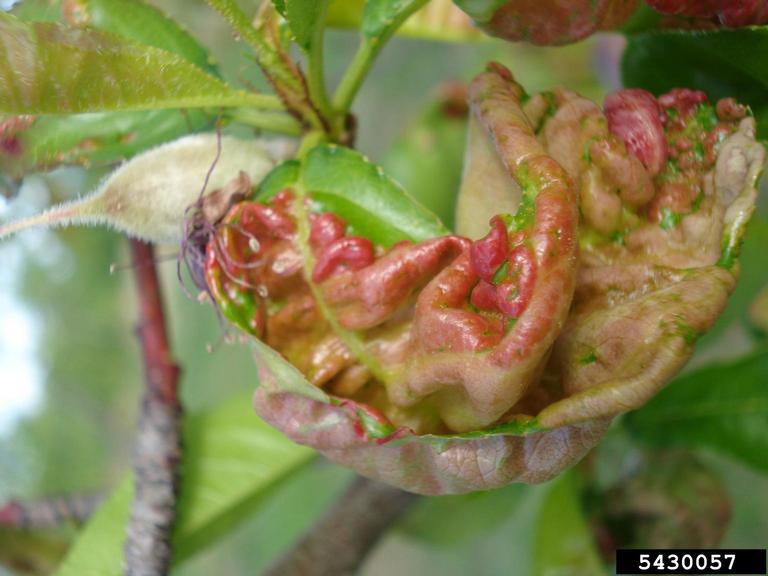
Two odd diseases that may occur on home-grown peaches and plums are called peach leaf curl (photo above) and plum pockets. Peach leaf curl is common and widespread, and can be found in Nebraska wherever peaches are grown although it is usually not severe in the drier areas of western Nebraska. The disease is favored by the milder, wetter climate of eastern Nebraska.
Although leaf curl is principally a disease of peaches, nectarines also can be infected. Related fungi of the Taphrina genus cause similar diseases such as plum pockets and leaf blisters on oak, maple, and elm.
Symptoms
Peach leaf curl, caused by Taphrina deformans, is easy to recognize. The most characteristic symptoms are curling and crinkling of the leaves as they unfurl in spring. Usually, the entire leaf is affected, but sometimes only small areas are involved. In addition to curling, diseased leaves are thickened and often turn red or pink. As the season progresses, diseased leaves turn gray and appear powdery. This is the result of the fungal pathogen producing spores on the leaf surface. Eventually, the leaves turn yellow or brown and are prematurely cast.
This disease may also occur on fruit, blossoms, and young twigs. Diseased fruits are distorted, swollen, and exhibit discolored surface areas. These areas are usually wrinkled and lack the normal peach fuzz. Infected fruits seldom remain on the tree until harvest. A severely disease tree does not yield well and is subject to winter injury.
Plum pockets, a disease caused by a similar fungus, Taphrina communis, causes similar symptoms on plum leaves, while the plums become distorted and puffy. This disease is not considered a serious problem in most cultivated plums. Wild plums, however, are highly susceptible. If necessary, the same control procedures used to prevent peach leaf curl may be used to minimize plum pockets.
Disease Spread
Fungal spores are produced on the surface of diseased leaves and are washed or blown onto twigs and leaf buds. When these buds break open in the spring, the spores come in contact with the young, unexpanded leaves. When environmental conditions are cool and wet, the spores germinate and infect the leaf tissue. Infected cells do not develop normally due to the secretion of growth regulating chemicals by the fungus. This results in abnormal cell division and enlargement giving the leaves a curled and crinkled appearance. Only expanding leaves are susceptible to infection.
Control
Fortunately, peach leaf curl and plum pockets are two of the easiest fruit diseases to control. In most years, a single application of chlorothalonil fungicide provides control. Lime sulfur, Bordeaux mixture, or a copper fungicide, are also effective at controlling both diseases.
Because infection occurs when the buds begin to swell, the fungicide must be applied during the dormant season. In Nebraska this can be done in the fall, after the leaves have dropped, through late winter. Remember, for effective disease control the fungicide must be applied at the proper time, and the tree must be thoroughly covered with the fungicide spray. When applying any fungicide, be sure to read and follow the label directions.